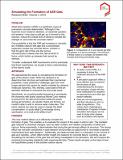Research Brief: Simulating the Formation of ASR Gels
Author(s)
Dupuis, Romain; Pellenq, Roland
DownloadASR_Research_Brief_2019.pdf (795.1Kb)
Metadata
Show full item recordAbstract
Alkali-silica-reaction (ASR) is a significant cause of premature concrete deterioration. Although it has received much research attention, an essential question still remains—how does a soft gel, as is formed by this reaction, induce the critical level of stress to exceed the strength of, and crack the concrete matrix? One possibility is that the ASR gel increases in viscosity as it imbibes calcium with age and a concomitant expansion causes the concrete failure. Another is that the gel’s rate of flow into the porous microstructure is slower than the rate at which it forms, which builds up stresses that cannot be relieved. To better understand ASR mechanisms and to eventually test these hypotheses, we sought a basic understanding at the atomic scale.
Date issued
2019-04Series/Report no.
MIT CSHub Research Brief; Volume 2019, Issue 3
Keywords
Poromechanics, Cement, Alkali-silica Reaction